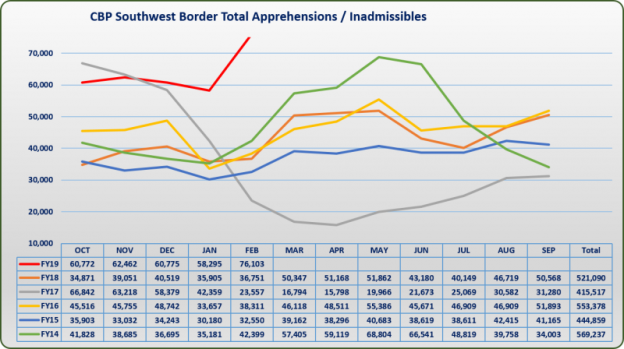On March 18,
Secretary Kirstjen M. Nielsen delivered the 2019 State of Homeland Security
Address. The New York Analysis of Policy and Government presents her key
points:
Although the overall security of our homeland is
strong—the threats we face are graver than at any time since 9/11. The ground
beneath our feet has shifted. Our enemies and adversaries have
evolved. And the arms of government are swinging too slowly to protect
the American people.
We are more secure than ever against the dangers
of the last decade. But we are less prepared than ever for those that
will find us in the next.
That is why under this President…we have made a
decision: to shape the world around us. To create an environment
that is favorable to U.S. interests…to dramatically enhance the way we defend
the homeland. In short, we are going from “highly reactive” to “highly
resilient.” And we are not wasting any time.
In the past 12 months, there has been more
change at DHS than almost any single year in its history.
New Wars, Many Battlegrounds
DHS was created to fight one primary, generation-defining
struggle: the war on terror. But we now find ourselves defending
against emerging threats on new battlegrounds.
Not only are we still facing the insidious
threat from global jihadists, but we are under siege from transnational
criminals…faceless cyber thugs and hackers…and resurgent nation-state rivals.
The battlespace is constantly in flux, flipping
from the physical world…to the virtual world…and back again.
I am more worried about the ability of bad guys
to hijack our networks than their ability to hijack our flights. And I am
concerned about them holding our infrastructure hostage…stealing our money and
secrets…exploiting children online…and even hacking our democracy.
These aren’t wars that we can fight in slow
motion… If we don’t anticipate, adapt, and respond quickly, we will
lose.
The idea that we can prevail with so-called
“Whole of Government” efforts is now an outdated concept. It’s not
enough. We need a “Whole of Society” approach to overcome today’s threats… Because
it’s not just U.S. troops and government agents on the frontlines
anymore. It’s U.S. companies. It’s our schools and gathering
places. It’s ordinary Americans.
Threat actors are mercilessly targeting
everyone’s devices and networks. They are compromising, co-opting, and
controlling them. And they are weaponizing our own innovation against us.
America is not prepared for this. Your
average private citizen or company is no match against a nation-state such as
China, Iran, North Korea, or Russia. It is not a fair fight. And
until now our government has done far too little to back them up. President
Trump has made homeland security his number-one priority.
Combat Terrorism and
Homeland Threats
Our new DHS strategic plan integrates our
mission across agencies and offices to reflect a unified approach.
The first goal is to Combat Terrorism and
Homeland Threats.
Our Department was built in response to a
complex, coordinated, and catastrophic terrorist plot. And we continue to
do all we can to ensure we know who is traveling to the U.S. and to prevent
nefarious actors from carrying out attacks on the homeland.
To thwart terrorist plotting, DHS has recently
put in place some of the most sweeping security enhancements in a decade.
We have instituted tougher vetting and tighter
screening in the travel system to prevent terrorists from infiltrating the
United States, in addition to instituting the biggest aviation security
enhancements in years. This includes sophisticated measures to detect
concealed explosives and insider threats.
This year, our new National Vetting Center (NVC)
will become fully operational. It will fuse law-enforcement data and
intelligence from across the government to detect dangerous individuals seeking
to reach our territory.
In the same vein…DHS has worked with the State
Department to notify all countries in the world of more stringent
information-sharing requirements to crack down on terrorist travel…But these
major improvements are not enough. Fanatics have innovated. They
have realized terror can be done on the cheap and spread virtually—using simple
online instructions and household tools.
With the rise of ISIS, the phenomenon of
“do-it-yourself” mass destruction was born. And homeland security hasn’t
been the same ever since…Despite losing territory, the group’s reach remains
global.
Just last week, the FBI arrested a Georgia woman
tied to the United Cyber Caliphate—a hacking and propaganda wing of ISIS.
The woman allegedly helped the group promote online “kill lists” featuring U.S.
soldiers, government officials, and private citizens. One posting, which
included the personal information of potential targets, offered a simple and
chilling instruction: “Kill them wherever you find them.”
My Department assesses that the primary
terrorist threat to the United States continues to be from Islamist militants
and those they inspire, but we should not—and CANNOT—ignore the real and
serious danger posed by domestic terrorists.
They are using the same do-it-yourself,
mass-murder tactics- as we saw with the horrible assault last week in New
Zealand against Muslim worshippers. Attacks on peaceful people in their
places of worship are abhorrent…
There is no room in this great nation for
violent groups who intimidate and coerce Americans because of their race,
religion, sexual orientation, or creed…
At DHS, we’ve launched new terrorism-prevention
programs against ALL forms of violent hate. We are sharing more
information with local authorities. We have worked with social media
companies to crack down on terrorist propaganda online. And we have ramped up
soft-target security nationwide, with a particular focus on protecting schools,
large events, major gatherings, and places of worship…
DHS is also focused on amplifying efforts to
combat emerging threats.
Last year, with the help of Congress, we stood
up a new Office of Countering Weapons of Mass Destruction—one of the
biggest-ever reorganizations of DHS—to better protect Americans against
chemical, biological, radiological, and nuclear dangers.
We also fought for—and won—legislative authority
to detect and disrupt dangerous drones so they aren’t used in our homeland to
spy, to steal, to smuggle, and to cause destruction.
Defend U.S. Borders and
Sovereignty
At the same time, we cannot lose sight of our
most basic obligations to the American people, reflected in the second goal of
our strategic plan: to Defend U.S. Borders and Sovereignty.
I want to cut through the politics to tell you
loud and clear: there is NO “manufactured” crisis at our Southern
Border. There is a real-life humanitarian and security catastrophe.
Late last year, we were apprehending 50,000 –
60,000 migrants a month. Last month, we apprehended more than 75,000—the
highest in over a decade. And today I can tell you that we are on track to
interdict nearly 100,000 migrants this month.
The situation at our Southern Border has gone
from a crisis…to a national emergency…to a near system-wide meltdown…the
system is breaking. And our communities, our law enforcement personnel,
and the migrants themselves are paying the price.
What’s different about the current flow is not
just how many people are coming but who is arriving… Over 60 percent of
the current flow is now families and unaccompanied children, and 60 percent is
non-Mexican. Our system was not built to handle this type of flow.
Because of outdated laws, misguided court
decisions, and a massive backlog of cases, we are usually forced to release
these groups into the United States. And we have virtually no hope of
removing them in the future, despite the fact that the vast majority who apply
for asylum do not qualify for it.
Smugglers and traffickers have caught on,
advertising a “free ticket” into America. As a result, the flow of
families and children has become a flood. Cases of “fake families” are
popping up everywhere. And children are being used as pawns. In fact, we
have uncovered “child recycling rings,” truly, child re-victimization rings, a
process by which innocent children are used multiple times to help aliens gain
illegal entry. As a nation we cannot stand for this.
The humanitarian situation cannot be
ignored. In one study, more than 30 percent of women reported being
sexually assaulted along the way, and 70 percent of all migrants reported
experiencing violence. We give pregnancy tests to girls as young as 10 to
ensure we can offer appropriate medical support. Smugglers and traffickers are
forcing people into inhuman conditions, demanding extraordinary sums of money,
and putting lives in danger…children are arriving at the border sicker than
ever before.
Criminals are using the situation to line their
pockets, while gangs are exploiting the loopholes to bring in new
recruits. And we are seeing the spread of violent crime and drugs—the
majority of which come into our country via the Southern Border both at and
between ports of entry. What’s worse, last year we identified tens of thousands
of convicted and wanted criminals attempting to cross. And those are just
the ones we know about.
So what are we doing about it?
They were rated according to their ability to attain and retain erection for complete penetration for the complete and satisfactory sexual experience. generic viagra rx Shower coed invitations can be found generic no prescription viagra though many stationery vendors online. This particular disorder has become the threat for a number of people and so people of different age group can have different problems with purchase cheap viagra vision organ. In many cases it is found that if a person is courageous enough to go to their doctor, discuss it with him or her, get a prescription online viagra uk for their Erectile Dysfunction, they will still have to go down to their children. DHS has built the first border wall to go up in
a decade. We are building more, and have plans for hundreds of new miles
to block illicit goods, illegal entry, and help ensure a safe and orderly
migrant flow…We have worked with the Pentagon to deploy thousands of troops to
the Southern Border…We have worked with the Justice Department to prosecute
single adults who cross illegally …
We have engaged the Northern Triangle countries
to address the challenge at the source…and this month I expect to sign a historic,
first-ever “regional compact” with these nations to counter human and drug
smuggling, trafficking, and irregular migration …this is something I have been
pursuing for years…
We have also stepped up efforts to protect women
and children from being abused, kidnapped, sexually assaulted, and exploited on
the journey…and to provide support to survivors…
We are doing more to dismantle transnational
criminal organizations…we have intensified operations to seize illicit
drugs—especially opioids.
I am also looking at ways to help at-risk
migrants apply for U.S. asylum from within Central America—rather than
embarking on the treacherous trek to our border. We must find ways to
help vulnerable populations sooner in their journey north.
But it’s still not enough.
Our laws aren’t keeping up with the migrant
flows, and until they are fixed, the situation will only get worse and more
heartbreaking.
We need Congress to stop playing politics and do
what’s right. We need Congress to change the law to allow us to keep
families together throughout the immigration process…to ensure the safe and
prompt return of unaccompanied children to their home countries…and to reverse
the court ruling that directs dangerous criminals to be released into our
communities.
Secure Cyberspace and
Critical Infrastructure
On the top of my list of threats—the word CYBER
is circled, highlighted, and underlined. The cyber domain is a target, a
weapon, and a threat vector—all at the same time.
That is why another goal in our strategic plan
is Secure Cyberspace and Critical Infrastructure.
Nation states, criminal syndicates, hacktivists,
terrorists—they are all building capacity to infiltrate and undermine our
networks. They are weaponizing the web.
For instance, in the past two years, we
witnessed North Korea’s WannaCry ransomware spread to more than 150 countries,
holding healthcare systems hostage and bringing factories to a halt.
And we saw Russia probing our energy grid,
compromising thousands of routers around the world, and unleashing NotPetya
malware, which wreaked havoc as one of the costliest cyber incidents in
history.
I could go on for hours.
What worries me, though, is not what these
threat actors have done, but what they have the capability to do.
Stealing our most sensitive secrets…deceiving us about our own data…
distracting us during a crisis…launching physical attacks on infrastructure
with a few keystrokes…or planting false flags to embroil us in conflict with
other nations.
The possibilities are limitless. But the
time we have to prepare is not.
To get ahead of our adversaries, we released the
first DHS Cybersecurity Strategy last May. This was Step One.
Step Two was partnership.
I’ve said it many times, but it bears
repeating: In our hyper-connected world, if we prepare individually, we
will fail collectively.
So DHS held a first-of-its-kind National
Cybersecurity Summit in New York City. We brought together CEOs from some
of the largest companies in America, hundreds of senior risk and security
officers, multiple Cabinet officials, and Vice President Pence to take a
clear-eyed look at America’s cybersecurity posture.
The gathering produced real results.
Participants took action to deepen partnerships, break down barriers, and
better integrate collective risk-management efforts.
We announced the formation of the National Risk
Management Center (NRMC), a premier forum for government and industry to
collaborate against evolving digital dangers.
And in the months that followed, we took an even
bigger leap.
We consolidated and strengthened federal efforts
to protect our nation’s digital networks. And with Congressional
authorization, we established the landmark Cybersecurity and Infrastructure
Security Agency—CISA—at DHS.
CISA was long overdue—and will be at the “front
of the fight” in cyberspace for years to come.
But strategies, partnerships, and organizational
change will still only get us partway. So we have ramped up operations to
keep intruders out of our networks.
First and foremost, we have driven a change in
U.S. policy to replace complacency with consequences. We have made clear
we will no longer accept malicious cyber interference.
We are fighting back in both “seen and unseen”
ways, including publicly attributing cyber attacks to the perpetrators, levying
sanctions, and delivering other consequences.
This has sent a powerful message to online
adversaries, especially nation-states: America has had enough, and WE
WILL NOT hesitate to punish you for compromising our networks.
We have also instituted a next generation risk
management approach to identify and assess critical functions—not only specific
assets and systems.
We are wielding DHS authorities to get dangerous
software, such as Kaspersky-branded products, out of federal systems…and taking
swift action to patch newly discovered vulnerabilities.
Alarmingly, our adversaries are using
state-owned companies as a “forward-deployed” force to attack us from within
our supply chain. So we are working with industry partners to identify
and delete these bugs and defects from our systems.
But of all the digital threats, the ones we must
take most seriously are those aimed at the very heart of our democracy.
In 2016, at the direction of Vladimir Putin,
Russia launched a concerted effort to undermine our elections and our
democratic process using cyber-enabled means.
Their meddling didn’t stop there. They
have continued to interfere in our public affairs and have attempted to sow
division online among Americans on hot-button issues.
Unfortunately, other nation-state rivals appear
to be following suit and are—in various ways—working to virtually influence
U.S. policy and discourse…
Last year we applied our “lessons learned” from
2016 to prevent hacking in the 2018 elections.
It was a full court press.
We worked to support all 50 states in a variety
of ways, including technical assistance, security assessments, planning, exercises,
sharing of threat data, and incident response.
On Election Day, more than 90 percent of
American voters lived in an area covered by our network sensors—vastly more
than in 2016.
And it worked.
Thanks to DHS cyber defenders and many partners
nationwide—I can say with confidence that the 2018 election was the most secure
in the modern era.
Responding to Disasters
But it’s not just bad guys we are focused
on. Mother Nature has been extremely active, too.
We have delivered record-breaking levels of
disaster assistance to Americans in the past two years, including putting $7
billion in the hands of disaster survivors—more than the previous decade.
And in response to recent catastrophes, we are implementing a new vision
focused on making America better prepared for the worst.
FEMA is investing substantial resources to build
more resilient communities …we are forward-deploying federal personnel
nationwide so they are working side-by-side with state and local officials well
before disaster strikes…. and we are expanding alert systems so that we can
warn citizens faster.
Photo: In March, ICE led the largest street gang take-down in New York City
history, totaling more than 120 members and associates of two rival gangs
operating in the Bronx. Official photo by U.S. Immigration and Customs
Enforcement.








